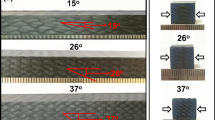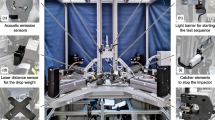In this study, the impact and post-impact behavior of three-dimensional (3D) four-directional carbon/epoxy braided composites having different braiding angles were investigated. The same impact energy (45 J) was applied to the specimens. The post-impact mechanical properties of the materials were performed by compression after impact (CAI) testing, and the processes were monitored by the acoustic emission (AE) technique. Results showed that the specimens with larger braiding angle sustained higher peak loads, and smaller impact damage area, mainly attributed to a more compact space arrangement. The CAI strength and damage mechanism were found to be mainly dependent on the axial support of the braiding fiber tows. Increasing the braiding angle of the composites, the CAI strength was reduced, and the damage mode of the composites was changed from transverse fracture to shear one. Combining AE parameters and CAI curves allows one to characterize the failure process, thereby enabling fracture analysis of the materials under study.








Similar content being viewed by others
References
T.-W. Chou and F. K. Ko, Textile Structural Composites, Elsevier, Amsterdam (1989).
L. Chen, X. M. Tao, and C. L. Choy, “On the microstructure of three-dimensional braided performs,” Compos. Sci. Technol., 59, 391–404 (1999).
S. Abrate, Impact on Composite Structures, Cambridge University Press (1998).
M. Shake, F. Ko, and J. Song, “Comparison of the low and high velocity impact response of Kevlar fiber-reinforced epoxy composites,” J. Compos. Tech. Res., 21, 224–229 (1999).
T. Zeng, D. N. Fang, and T. J. Lu, “Dynamic crashing and impact energy absorption of 3D braided composite tubes,” Mater. Lett., 59, 1491–1496 (2005).
J. D. Littell, W. K. Binienda, W. A. Arnold, et al., “Effect of microscopic damage events on static and ballistic impact strength of triaxial braid composites,” Compos. Part A-Appl. S., 40, 1846–1862 (2009).
B. H. Gu and J. G. Xu, “Finite element calculation of 4-step 3-dimensional braided composite under ballistic perforation,” Compos. Part B-Eng., 35, 291–297 (2004).
B. Z. Sun and B. H. Gu, “High strain rate behavior of 4-step 3D braided composites under compressive failure,” J. Mater. Sci., 42, 2463–2470 (2007).
Y. Zhang, B. Z. Sun, and B. H. Gu, “Experimental characterization of transverse impact behaviors of four-step 3-D rectangular braided composites,” J. Compos. Mater., 46, No. 24, 3017–3029 (2012).
M. Dale, B. A. Acha, and L. A. Carlsson, “Low velocity impact and compression after impact characterization of woven carbon/vinylester at dry and water saturated conditions,” Compos. Struct., 94, 1582–1589 (2012).
H. Yan, C. Oskay, A. Krishnan, and L. R. Xu, “Compression-after-impact response of woven fiber-reinforced composites,” Compos. Sci. Technol., 70, No. 14, 2128–2136 (2010).
G. Minak and D. Ghelli, “Low velocity impact and compressive after impact tests on thin carbon/epoxy laminates,” Compos. Part B-Eng., 42, 2067–2079 (2011).
K. T. Tan, N. Watanabe, Y. Iwahori, and T. Ishikawa, “Effect of stitch density and stitch thread thickness on compression after impact strength and response of stitched composites,” Compos. Sci. Technol., 70, 587–598 (2012).
G. Q. Zhang, B. Wang, L. Ma, et al., “The residual compressive strength of impact-damaged sandwich structures with pyramidal truss cores,” Compos. Struct., 105, 188–198 (2013).
A. Aktas, M. Tercan, M. Aktas, and F. Turan, “Investigation of knitting architecture on the impact behavior of glass/epoxy composites,” Compos. Part B-Eng., 46, 81–90 (2013).
B. Vieille, V. M. Casado, and C. Bouvet, “Influence of matrix toughness and ductility on the compression-after-impact behavior of woven-ply thermoplastic- and thermosetting- composites: A comparative study,” Compos. Struct., 110, 207–218 (2014).
X. M. Zhuang and X. Yan, “Investigation of damage mechanisms in self-reinforced polyethylene composites by acoustic emission,” Compos. Sci. Tech., 66, 444–449 (2006).
S. C. Woo and T. W. Kim, “High-strain-rate impact in Kevlar-woven composites and fracture analysis using acoustic emission,” Compos. Part B-Eng., 60, 125–136 (2014).
Acknowledgments
The authors would like to thank the National Natural Science Foundation of China (11102055, 11272110), the Science and Technology Innovation Team of Heilongjiang Department of Education (12521102).
Author information
Authors and Affiliations
Corresponding author
Additional information
Translated from Problemy Prochnosti, No. 1, pp. 220 – 227, January – February, 2017.
Rights and permissions
About this article
Cite this article
Yan, S., Guo, L.Y., Zhao, J.Y. et al. Effect of Braiding Angle on the Impact and Post-Impact Behavior of 3D Braided Composites. Strength Mater 49, 198–205 (2017). https://doi.org/10.1007/s11223-017-9858-4
Received:
Published:
Issue Date:
DOI: https://doi.org/10.1007/s11223-017-9858-4




